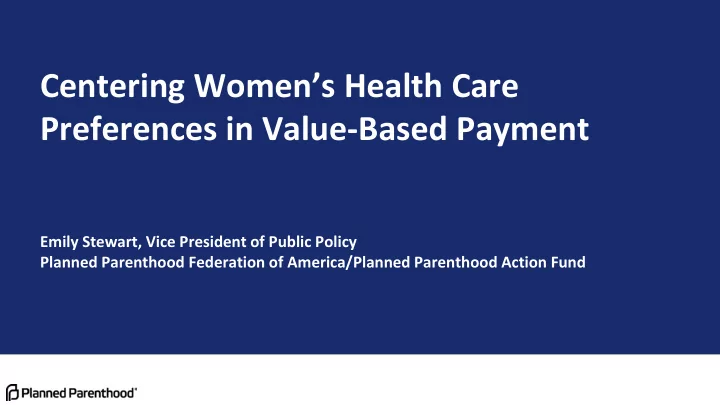

Centering Women’s Health Care Preferences in Value-Based Payment Emily Stewart, Vice President of Public Policy Planned Parenthood Federation of America/Planned Parenthood Action Fund
Trusted health care advocate, provider & educator. 600+ 55 320% 1.5+ Health centers Affiliates increase in million people reached patients served through education online since 2016 programs annually
Planned Parenthood health centers served 2.4 million patients last year: Our reach 85% 1 out of every 3 women in the were 20 years of age or older U.S. will visit a Planned Parenthood health center in 11% her lifetime. were men 67% of all women of reproductive age are within a More than 30-minute drive of at least 1/3 one Planned Parenthood were people health center. of color
We are facing a women’s health crisis
Women of reproductive age have told us how & where they want to access care...
...But new models aren’t responding. Almost all of the current system change efforts fail to adequately account for the Broader Health Women’s unique needs of women — Health Care System Care while also limiting access to the providers they trust.
The conversation is evolving 2013-2014 2015-2016 2017-2018 Early models failed to States began including Some states have take into account the women's health care developed VBP programs savings & value of measures in programs, & strategies targeted at preventive services, linking payment & value the needs of women of including the family to these services for the reproductive age planning services women first time. (e.g.Washington, North need. Carolina).
Washington State’s largest affiliate has built relationships with several Accountable Communities of Health, which have supported the affiliate with grant dollars to expand access to behavioral health care & serve as a key resource for several reproductive health projects. New York State’s nine affiliates leveraged DSRIP-driven partnerships to expand access to primary care, develop care coordination teams to address the social determinants of health, & employed telehealth to connect patients behavioral health care providers. In Connecticut , our affiliate advocated to change the Medicaid patient- centered medical home program to grant their health centers access to increased reimbursement to support the addition of expanded primary care, care coordination, & a behavioral health co-location model.
What we have learned: ● VBP program flexibility opens up more opportunities to reach women & the providers that serve them ● A supportive culture of change & focus on clinician buy-in are essential to success ● Policy & operations is a critical marriage — without a partnership, programs miss the intended mark
“Of all the forms of inequality, injustice in health care is the most shocking and inhumane.” – Martin Luther King Jr.
Recommend
More recommend